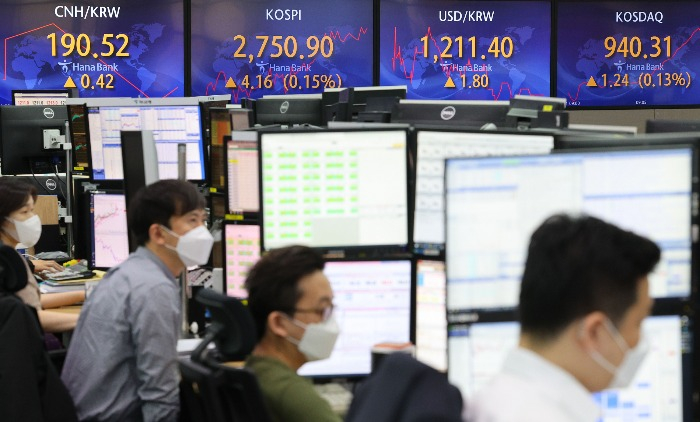Korean stock market
Mid-cap, small-cap outperform large-cap stocks in Q1 2022
Massive funds outflew from the large-cap stocks due to some biggest IPOs and foreigners' sales of shares
By Apr 01, 2022 (Gmt+09:00)
2
Min read
Most Read
Samsung shifts to emergency mode with 6-day work week for executives


CJ CheilJedang to sell feed, livestock unit for $1.4 bn


Samsung Electronics' key M&A man returns; big deals in the offing


Affinity to buy SK Rent-a-Car at $572 mn, more deals expected


Keppel REIT to sell Seoul-based prime office T Tower



The large-cap index in the main Kospi dropped by 6.58% from January 1 to March 31 of this year, according to Korea Exchange (KRX). It compares with a 2.93% fall in the mid-cap stock index and a 1.5% rise in the small-cap index during the same period. In the secondary bourse Kosdaq, the large-cap index plunged by 13.93% during the first quarter; the mid-cap and small-cap indices had smaller losses, seeing 6.29% and 1.86% falls, respectively.
In both Kospi and Kosdaq markets, large-cap shares represent the top 100 ranks in terms of market capitalization. In the Kospi, mid-cap stocks are from the top 101 to 300 market caps, followed by small-cap shares under the top 300. In the Kosdaq, mid-cap stocks are between the top 101 to 400 ranks and the followings are defined as small-cap shares.┬Ā┬Ā
The large-cap stocks became bearish last year. The Kospi's large-cap share index rose by only 1.6%, while mid-cap and small-cap indices jumped by 11.59% and 16.57%, respectively. It compares with the main bourse in 2020 when the large-cap index hiked by 31.54%, similar to the mid-cap indexŌĆÖs 31.98% increase and much higher than the small-cap indexŌĆÖs 22.13% up.┬Ā ┬Ā
REBOUND IN Q2 2022 EXPECTED
Market watchers say some of the recent IPOs smashed the large-cap stocks. The passive funds chasing the market indices dumped some large-cap shares and added the top IPO shares in their portfolios instead, such as SK IE Technology Co., KakaoBank Corp., Krafton Inc. last year and LG Energy Solution Ltd. early this year.┬Ā
Foreign investorsŌĆÖ massive sales of Korean shares also damaged large-cap stocks. Foreigners sold a net 5.4 trillion won ($4.4 billion) worth of shares on the Kospi for the first quarter. In the top 10 market caps, foreigners only picked SK Hynix Inc. and LG Chem Ltd. with net purchases of 1.2 trillion won and 955.5 billion won, respectively.┬Ā ┬Ā
Market watchers expect a rebound of large-cap stocks in the second quarter as the fundamentals of the stocks are more robust than that of mid- and small-cap shares. ForeignersŌĆÖ holding rate in the Kospi market has fallen to the lowest level after the global financial crisis, signing foreign investorsŌĆÖ withdrawal has almost come to the end.┬Ā ┬Ā┬Ā
The estimated operating profits from the large-cap stocks rose by 2.8% this year, while that of mid-cap stocks fell by 2.1%, said Choi Jae-won, an analyst at KoreaŌĆÖs Kiwoom Securities Co. in a report on March 28. ŌĆ£By diversifying their businesses, large-cap companies would be able to ease the shocks from inflation and hikes in raw materials prices. As a result, large-cap stocks will see very limited drops in their return of equity (ROE) in 2022,ŌĆØ he added.
"From April, Korean companies will start announcing their performances for the first quarter, and shareholders will focus on the deterioration of their profitability. Investors need to select the large-cap stocks that steadily carry earnings momentum amid pressures of cost increases,ŌĆØ said Choi.
Write to Hyeong-Gyo Seo at seogyo@hankyung.com
Jihyun Kim edited this article.
More to Read
-

-

-
 Year-end reviewKosdaq: Perennial bush league as blue chips favor Kospi
Year-end reviewKosdaq: Perennial bush league as blue chips favor KospiDec 28, 2021 (Gmt+09:00)
3 Min read -

-
 MarketsForeigners buy Kospi futures to raise bullish bets on Korea stocks
MarketsForeigners buy Kospi futures to raise bullish bets on Korea stocksDec 09, 2021 (Gmt+09:00)
2 Min read
Comment 0
LOG IN


